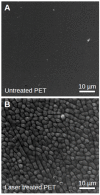Adaptive camouflage: what can be learned from the wetting behaviour of the tropical flat bugs Dysodius lunatus and Dysodiusmagnus
- PMID: 28811303
- PMCID: PMC5576082
- DOI: 10.1242/bio.026070
Adaptive camouflage: what can be learned from the wetting behaviour of the tropical flat bugs Dysodius lunatus and Dysodiusmagnus
Abstract
The neotropical flat bug species Dysodius lunatus and Dysodius magnus show a fascinating camouflage principle, as their appearance renders the animal hardly visible on the bark of trees. However, when getting wet due to rain, bark changes its colour and gets darker. In order to keep the camouflage effect, it seems that some Dysodius species benefit from their ability to hold a water film on their cuticle and therefore change their optical properties when also wetted by water. This camouflage behaviour requires the insect to have a hydrophilic surface and passive surface structures which facilitate the liquid spreading. Here we show morphological and chemical characterisations of the surface, especially the cuticular waxes of D. magnus Scanning electron microscopy revealed that the animal is covered with pillar-like microstructures which, in combination with a surprising chemical hydrophilicity of the cuticle waxes, render the bug almost superhydrophilic: water spreads immediately across the surface. We could theoretically model this behaviour assuming the effect of hemi-wicking (a state in which a droplet sits on a rough surface, partwise imbibing the structure around). Additionally the principle was abstracted and a laser-patterned polymer surface, mimicking the structure and contact angle of Dysodius wax, shows exactly the behaviour of the natural role model - immediate spreading of water and the formation of a thin continuous water film changing optical properties of the surface.
Keywords: Bug biomimetics; Camouflage; Laser structuring; Liquid-surface interaction; Microstructures; Reflectance; Wetting.
© 2017. Published by The Company of Biologists Ltd.
Conflict of interest statement
Competing interestsThe authors declare no competing or financial interests.
Figures









References
-
- Ångström A. (1925). The Albedo of various surfaces of ground. Geogr. Ann. 7, 323 10.2307/519495 - DOI
-
- Arenholz E., Svorcik V., Kefer T., Heitz J. and Bäuerle D. (1991). Structure formation in UV-laser ablated poly-ethylene-terephthalate (PET). Appl. Phys. A 53, 330-331. 10.1007/BF00357196 - DOI
-
- Bormashenko E. Y. (2013). Wetting of Real Surfaces. Berlin; New York: De Gruyter.
LinkOut - more resources
Full Text Sources
Other Literature Sources

